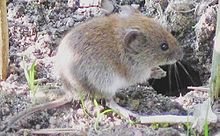Võle
| Vole | |
|---|---|
 |
|
| The bank vole (Myodes glareolus) lives in woodland areas in Europe and Asia. | |
| Scientific classification | |
| Kingdom: | Animalia |
| Phylum: | Chordata |
| Class: | Mammalia |
| Order: | Rodentia |
| Family: | Cricetidae |
| Subfamily: |
Arvicolinae in part |
| Genera | |
|
See text. |
|
See text.
A vole is a small rodent; a relative of the mouse, with a stouter body, a shorter, hairy tail, a slightly rounder head, smaller ears and eyes, and differently formed molars (high-crowned and with angular cusps instead of low-crowned and with rounded cusps). There are approximately 155 species of voles. They are sometimes known as meadow mice or field mice in North America and Australia. Vole species form the subfamily Arvicolinae with the lemmings and the muskrats.
Voles are small rodents that grow to 3–9 in (7.6–22.9 cm), depending on the species. They can have five to 10 litters per year. Gestation lasts for three weeks and the young voles reach sexual maturity in a month. As a result of this biological exponential growth, vole populations can grow very large within a very short time. Since litters average five to 10 young, a mating pair can birth a hundred more voles in a year.
Voles outwardly resemble several other small animals. Moles, gophers, mice, rats, and even shrews have similar characteristics and behavioral tendencies. Since voles commonly use burrows with many exit holes, they can be mistaken for gophers or some kinds of ground squirrels.
Voles thrive on small plants, yet like shrews, they will eat dead animals, and like mice or rats, they can live on almost any nut or fruit. Additionally, voles target plants more than most other small animals, making their presence evident. Voles readily girdle small trees and ground cover much like a porcupine. This girdling can easily kill young plants and is not healthy for trees or other shrubs.
...
Wikipedia
